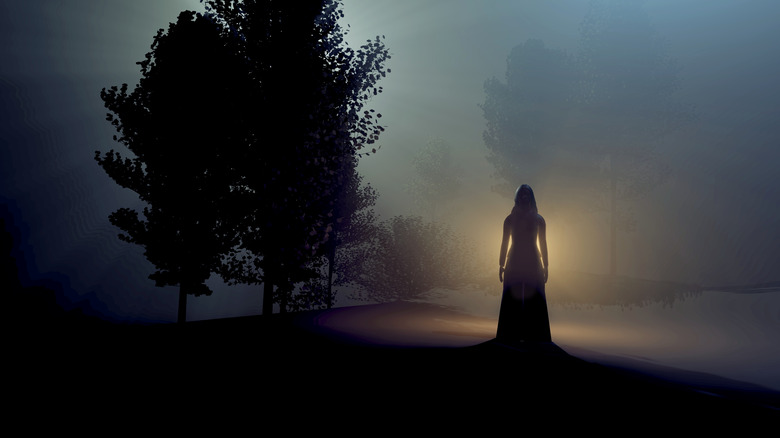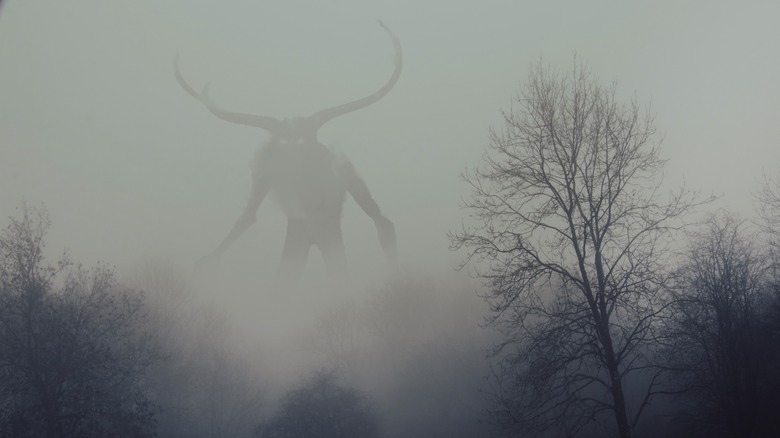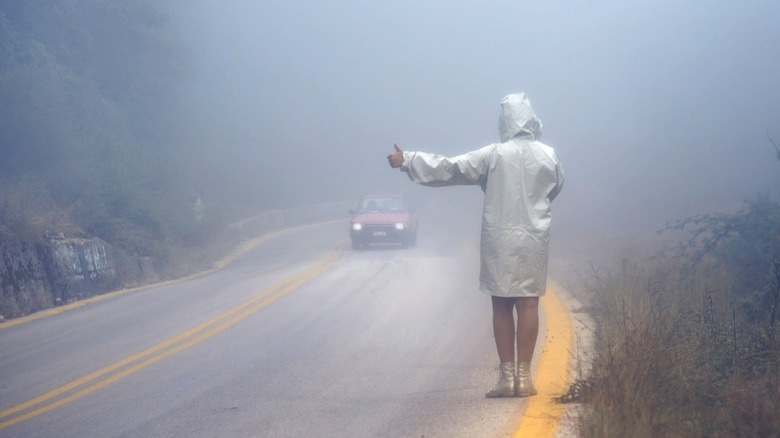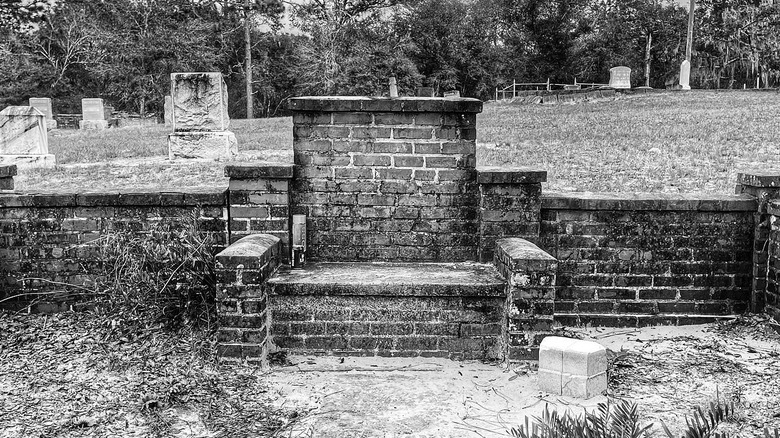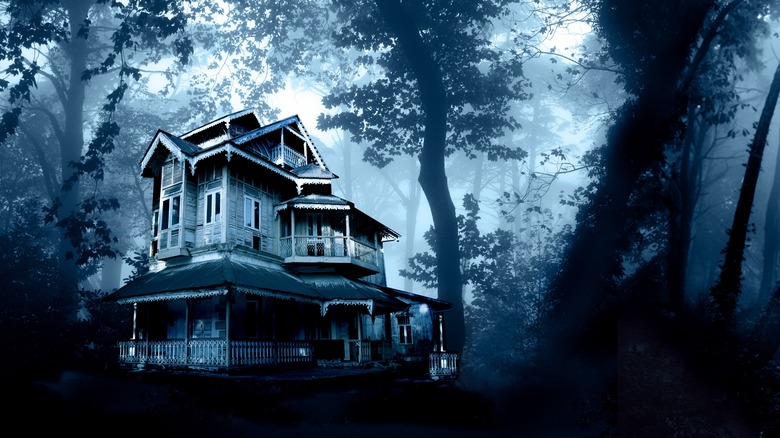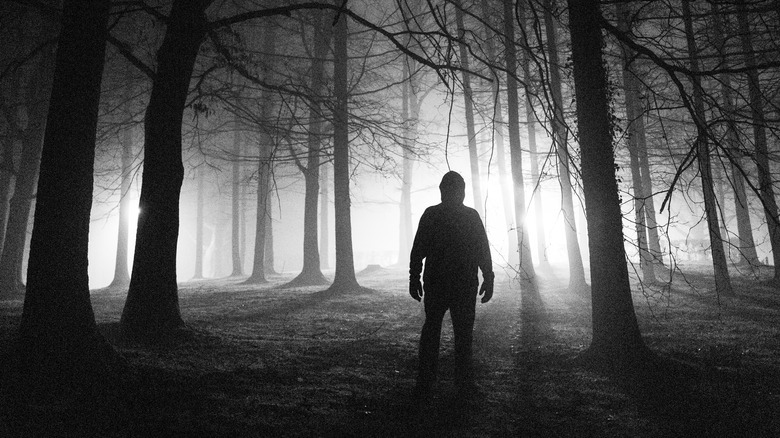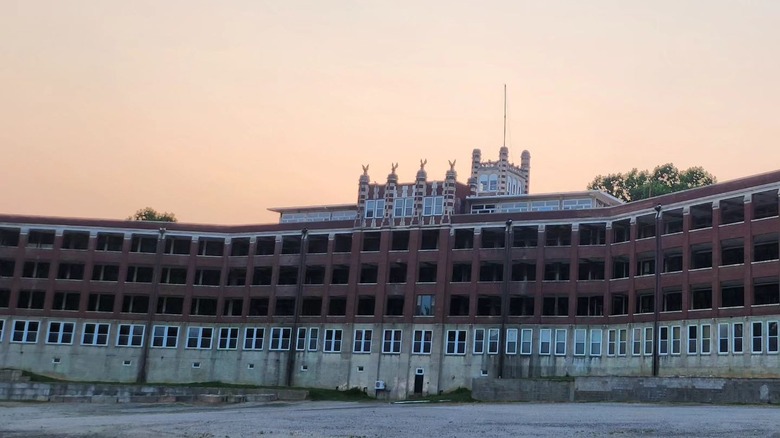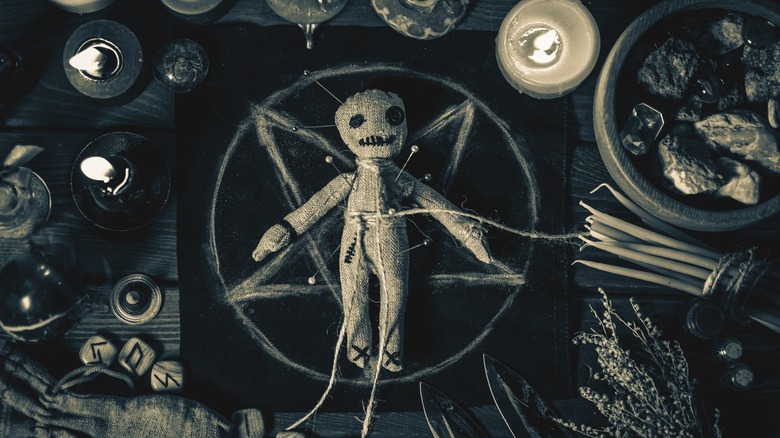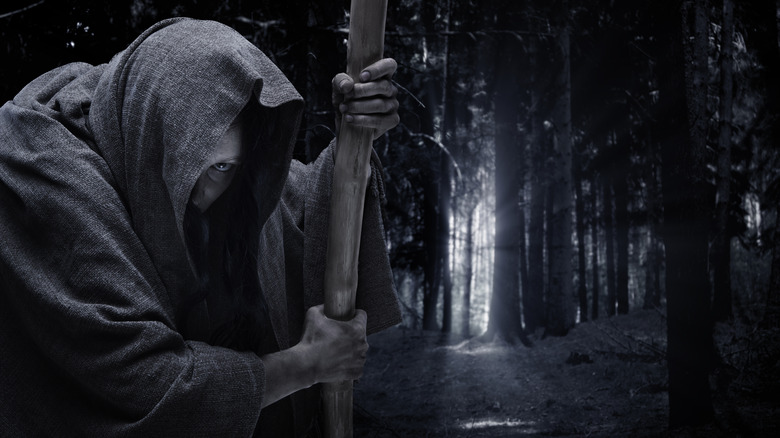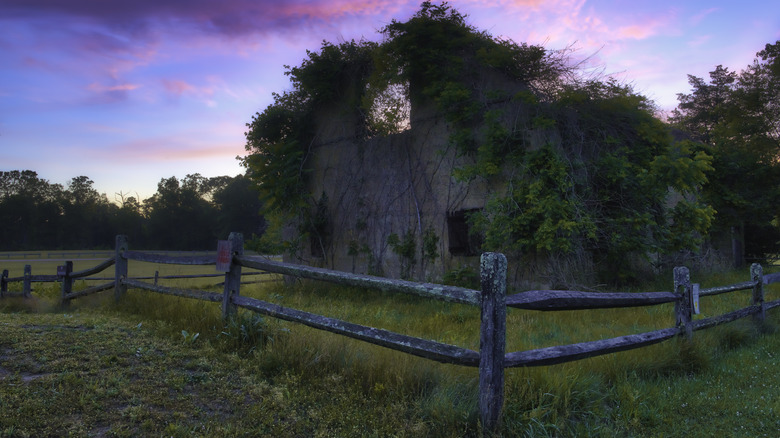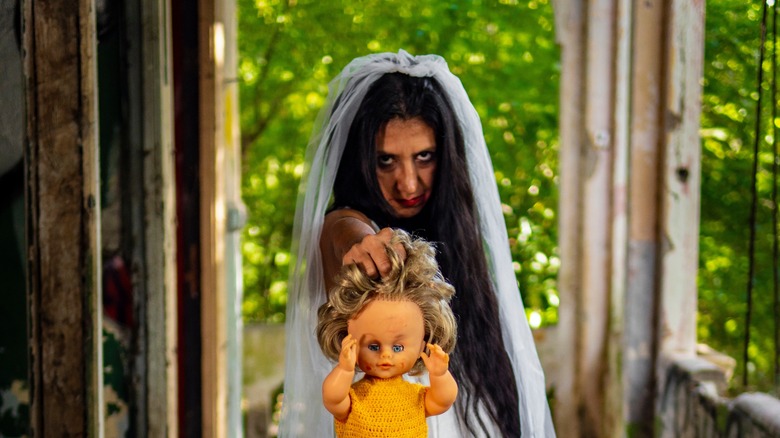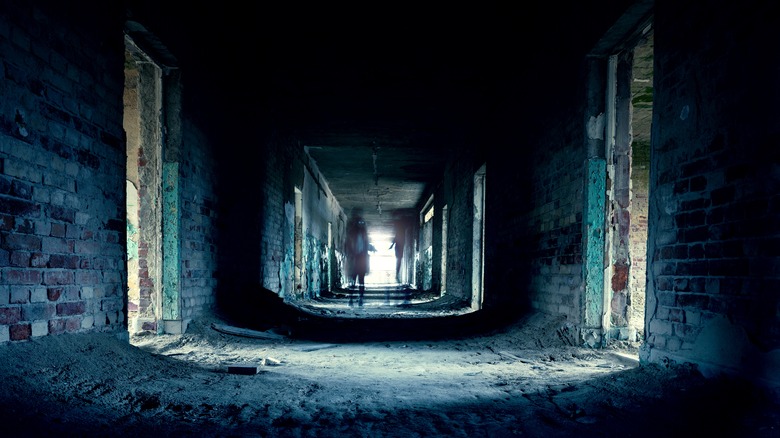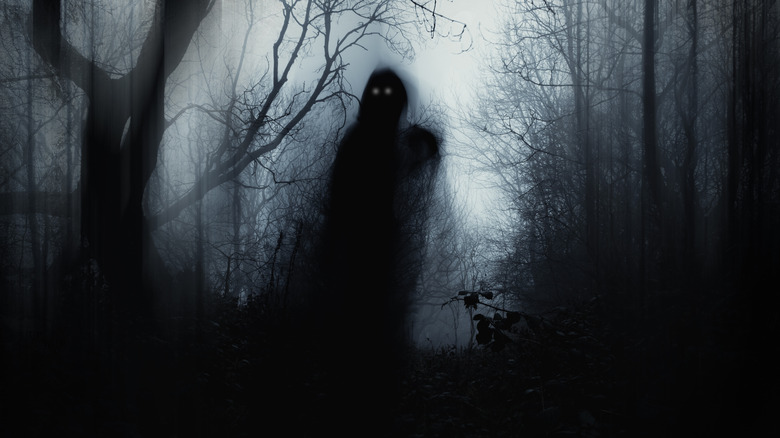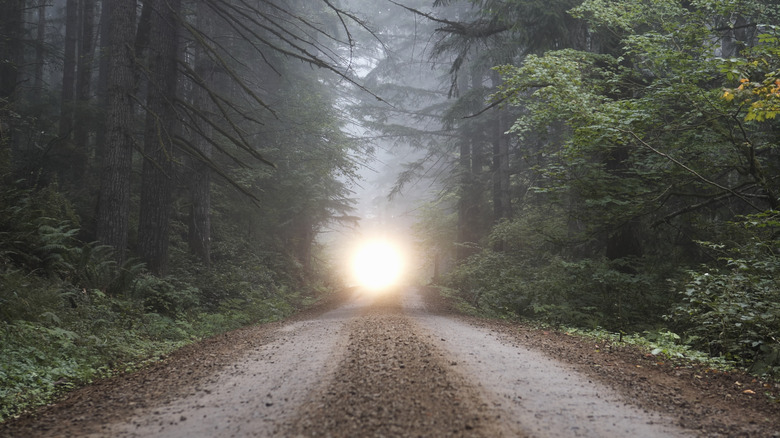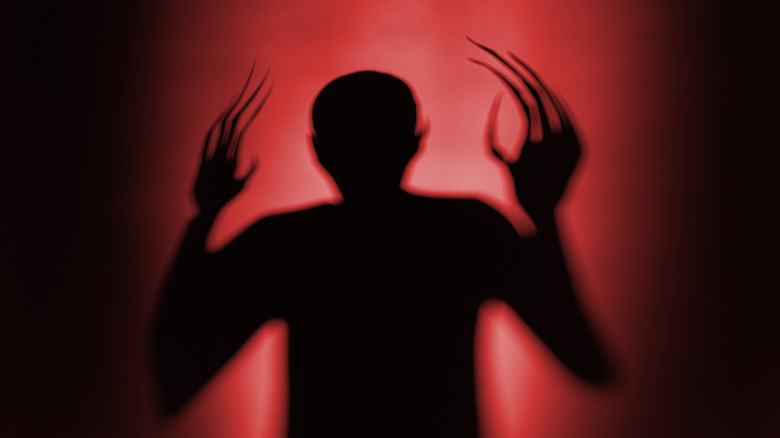The Most Popular Urban Legend In Every State
That smartphone you're reading this article on is a ghost slayer. At least, that's what Tony Cornell, scientific investigator for the Society of Psychical Research, believes. "Until a few years ago we'd receive reports of two new ghosts every week," Cornell told the Sunday Express (via Chron) in 2001. "But with the introduction of mobile phones 15 years ago, ghost sightings began to decline to the point where now we are receiving none."
The paranormally inclined see this as a smartphone's electromagnetic emittance driving specters away, but others see a simpler explanation: Now that everyone's got a camera in their pocket, word-of-mouth and undocumented sightings have unsurprisingly all but dried up. Urban legends that freaked people out with apparitions and creepy noises, it appears, get shy when you point an iPhone at them.
Still, urban legends hold powerful sway over our hearts and minds from a young age. They're a part of humanity's long history of riveting storytelling; goosebump-inducing tales that teach us important lessons about the human condition and try to explain the unexplainable. While many urban legends are based in fact, they all morph over time via a generational telephone game, creating fun little windows into history and the culture of when they were born. Today, we'll unearth the most popular urban legends in every U.S. state.
Alabama: Huggin' Molly
Cruising through southeastern Alabama's Henry County, you'll stumble upon Abbeville — once named "Yatta Abba" by the original Creek (Muscogee Nation) people. This unsuspecting, quaint colonial town is rumored to be home to a terrifying, seven-foot-tall woman who dresses all in black and prowls the streets at night with a singular purpose: bear-hugging children and shrieking deafeningly into their faces. "Anybody who grew up in Abbeville grew up knowing the legend of Huggin' Molly," says local Jimmy Rane on Huggin' Molly's website. "If your mother or dad didn't want you to be out after dark, they'd tell you Huggin' Molly would get you."
The story goes all the way back to the early 1900s, though like all urban legends, there are various origin stories. In some, Molly's the typical bereaved mother who spends her years in tortured limbo trying to alleviate her grief with living children. In others, she was a woman murdered during a nightly stroll. The most fleshed-out theory is that there was a professor at Alabama Agriculture School who, in life and death, sought to keep kids safe by terrorizing them off unsafe streets after dark. Or, maybe she's just a ghost who needs a hug. Whether myth or reality, Huggin' Molly is close enough to Abbeville's collective heart that there's a restaurant carrying her name: Huggin' Mollys.
Alaska: Cook Inlet's deadly mud flats
Alaska's urban legends are replete with native lore, secret research facilities, and UFO sightings. One that continues to this day — and has a basis in fact — is Cook Inlet's life-threatening mud flats. The flats are only a block away from downtown Anchorage in the Turnagain and Knik Arms of Cook Inlet. Exploring individuals who venture too close to the water, the stories go, find themselves stuck in a peculiar mud that gulps them down or leaves them trapped to drown in the rising tide. Effectively, a muddy quicksand. In one story, a woman in the mud gets torn asunder when a helicopter attempts to dislodge her with a rope around her waist.
The alleged gruesome deaths that have occurred in the flats are urban legend and therefore up for debate, but the mud flats' ability to kill is not. Anchorage Daily News inquired with a geologist who said of the mud, "The grains are highly angular ... When you step on it, you cause it to become more mobile. Then, when it resettles after you've disturbed it, it tends to be more compacted around your foot." Long story short, once you sink into this mud, it won't easily let you go. People have lost their lives to this, and still do, but it's not like the rescue team will have to watch from the banks as you die, as a 2001 rescue proved. Still, the legend persists.
Arizona: Navajo skinwalkers
The Navajo tribe currently numbers around 300,000 and inhabits the American southwest, with a large population in Arizona. The Navajo have been in the area for over a thousand years, appearing in Arizona circa the 1700s. Whether you're an Arizonan Boy Scout hearing ghost stories at Camp Geronimo or a backpacker enjoying a campfire under the Sonoran desert's peaceful skies, chances are you've heard of the skinwalkers. Legend has it that shamans (Navajo medicine men) would sometimes practice the "Witchery Way" for malicious purposes. In a sort of Faustian bargain, a shaman commits an unspeakable act in return for shapeshifting powers — among others. Thus, a skinwalker — or "yee naaldlooshii," as Navajo call them — is born.
Skinwalkers aren't just a spooky bedtime story for Navajos (who, by the way, won't mention the creatures by name). Skinwalkers will terrorize anyone they can, though most of their work appears to be of the trickster variety. They'll look into your window or knock on your walls. Some people report seeing a humanoid creature keeping pace with their car. Supposedly a skinwalker is not immortal, so they must continue gathering the dark resources they need to live on.
Some Navajos believe that skinwalkers were victims of the tragic Long Walk of the Navajo in 1864, driven to black magic for their own survival. The Navajo Witch Purge tried to end them in 1878, but the urban legends' survival to this day suggests it was unsuccessful.
Arkansas: Highway 365 hitchhiker
Woodson, Arkansas' Highway 365 has a bit of a reputation for the paranormal. Suppose you find yourself driving here during a rainy night. You spot a female hitchhiker, thumb up, standing on the roadside. Concerned for her safety, you hit the brakes and tell her to hop in. She gives you a destination to take her in the nearby town of Redfield, then quickly falls asleep. At the provided address, you get out and knock on the door. When you tell the woman who answers that you've brought what appears to be her daughter, her eyes go wide in shock. She tells you her daughter was struck dead by a car four years ago, to the day. You've just picked up the Highway 365 hitchhiker.
Though retellings change the details, the core of the story remains the same. According to Northwest Arkansas Democrat-Gazette, in response to a Facebook post by Only in Arkansas concerning the 365 Highway hitchhiker, multiple people gave their own take on the urban legend. Frankie Brooks believes it has some basis in reality. "Apparently there was an accident in Woodson in the 40s involving a young man and woman," Brooks wrote. There were "multiple reports of seeing the girl walking on 365 between the bridge and the town of Redfield ..." Another poster, Lisa Willis, added, "It's real. I've seen her. She chilled my bones." Still more have their own accounts. It would seem the mystery ghost girl continues trying to hitchhike home to this day.
California: Dark Watchers
Once you've seen the Golden Gate Bridge from the Lands End's Trail, your next California hike might be in the Santa Lucia Mountains. But keep your head on a swivel as you ascend. Up the peaks, you might spot a tall figure in a dark cloak staring back at you. Perhaps you look away, shaking your head at the thought of ghosts. Doing a concerned double-take, the figure seems to have vanished without a trace. That figure might have been one of California's notorious Dark Watchers.
This urban legend predates the USA and the state of California itself. Spanish colonizers dubbed them "Los Vigilantes Oscuros" (Spanish for "The Dark Watchers") after seeing the same apparitions. Many more have since, including famed poet Robinson Jeffers and John Steinbeck, author of "The Grapes of Wrath." Steinbeck even included the apparition in his short story "Flight," and his son Thomas penned a novel about the phenomenon. So what gives?
Well, it could be an occurrence of pareidolia, humanity's propensity to find patterns where there are none, i.e., seeing Jesus on your toast. Visitors may be misinterpreting long afternoon shadows (via Live Science). Or, it could be an old German optical illusion known as the "Brocken spectre" that occurs in misty mountain peaks like Santa Lucia.
Colorado: Stanley Hotel
Stanley Hotel is evidence that in some cases, an urban legend can grow via pop culture. That seems to be the case with Stanley Hotel in Colorado, which had a visitor in 1974 by the name of Stephen King. America's renowned horror author, then just getting started with breakout novels like "Carrie," spent the night in Room 217 with his wife Tabitha. The story goes that King selected the Stanley Hotel by opening a map at random. Allegedly, they were the last guests of the season, as the hotel was preparing to close for a cold, snowed-in winter — leaving a hauntingly empty, spooky place.
Now, there were some supposed ghost sightings already before King's arrival, such as a roaming housekeeper. But the hotel's newfound fame kicked off in earnest when King had a nightmare about a fire hose chasing his son around the hotel. Shaken, King said, "I got up, lit a cigarette, sat in the chair looking out the window at the Rockies, and by the time the cigarette was done, I had the bones of the book firmly set in my mind," according to Stephen King's website. That book's title? "The Shining." It's thanks to King that the urban legend — and the hotel — found new success. Horror aficionados flocked to the place en masse, and it's now regarded as one of the most haunted places in the world. You can even stay in Room 217, now known as the "Stephen King Suite," if you dare.
Connecticut: Charles Island
At first glance, Charles Island in Milford is nothing more than a 14-acre bird sanctuary accessible via a low-lying sandbar in a Natural Area Preserve of Connecticut. However, legends claim it's been cursed three times. The first came when a native Paugusset chief surrendered the land to European settlers in 1639. In vengeance, he cursed "any structure that was erected on the island and anyone who tried to live there," according to the Milford Mirror.
Fast forward to 1699, and the notorious pirate Captain Kidd was reaching the end of his rope. A series of unfortunate events led to a mutiny, a murder, and the loss of his ship. Returning to the colonies, the colonial governor of New York sent Kidd off to England for trial on charges of piracy. Kidd died in the gallows there. Before he went to his death, though, legend goes that he hid treasure in several locations, one of which was Charles Island. The second curse was ostensibly his, a warding against treasure hunters.
This wasn't the last time Charles Island would be charged with safekeeping. The third curse involves the 16th-century Aztec emperor Cuauhtémoc, who allegedly managed to hide away his people's treasure in a Mexican cave, which Connecticut sailors happened upon 200 years later in 1721. Plagued by suspiciously bad luck, the final surviving crew member relieved himself of the curse by burying the treasure on Charles Island. No one has found the treasure to this day (or Kidd's), but you can try. The island is open from September to April.
Delaware: Corpse Light
In 1655 on Christmas Day, the crew of the Devonshireman ship was looking for a safe harbor. They spotted a promising sign: a lighthouse's beacon off the coast of Cape Henlopen State Park in Delaware. They followed it, crashing the ship on the rocky shore and leading to the loss of the over 200 souls onboard. To add insult to injury, there was no lighthouse there at all. They'd fallen prey to the Corpse Lights, also known as a "Bad Weather Witch."
Legend goes that British soldiers once massacred a local tribe of Native Americans who were in the midst of a wedding celebration. The survivors of said event, in retaliation, enacted a "Drum of Stone" curse. And thus, the Corpse Lights would lure unwanted European visitors to a watery, rocky grave. The Devonshireman was its first known victim.
Curiously, a lighthouse was eventually constructed in this location in 1767, perhaps owing in part to fear of the Corpse Lights' deception. It lasted until 1924 when it collapsed as a result of the sand dune's eroding foundation. Despite this lighthouse, some believe the Bad Weather Witch also led to the demise of the HMS De Braak in 1798. Most recently, the S.S. Poet disappeared without a trace off Cape Henlopen in 1980, and though it's unclear what caused it to go down, some attribute it to the Corpse Lights. Legend aside, Delaware's coast makes for a great camp beside the Atlantic Ocean.
Florida: the Devil's Chair
Cemetery culture has changed over the years. Victorian-era folk treated burial grounds almost like a park, a place for picnicking and relaxation while visiting the dead. Some cemeteries from this time feature built-in brick "mourning" chairs, which, in the modern age, gave rise to new superstitions. Cassadaga, Florida, has a haunted cemetery with a chair like this, the so-called "Devil's Chair."
So how does it work? All you have to do is take a seat on the Devil's Chair at midnight and you'll hear the devil's voice. Apparently, Lucifer's a beer man, too; pop open a cool lager, leave it there, and come morning, the can will be empty. The legend is so popular that one company sells the eponymous "Devil's Chair" beer, complete with a picture of a fiery-red Satan lounging in that very mourning chair, beer raised to the viewer.
For those who have this experience, there could be any number of explanations as to why they hear the devil's disembodied voice. For all we know, it's just a mischievous friend whispering from behind them. But, as for the vanishing beer part, Reverend Louis Gates said, "People used to come and get drunk, come out to the graveyard, put their beer on a tombstone." In the Click Orlando article, Gates added, "But it wasn't the devil drinking the beer — it was us teenagers." In other words, underage, bored kids found a fun way to get drunk and, it would appear, inadvertently added more to the urban legend.
Georgia: Altie the Sea Monster
Loch Ness-type monsters are surprisingly common among cryptids. Accounts across the world report similar leviathans, and Georgia is one such place. Georgia's Altamaha River spans a massive 137 miles in one of the Atlantic seaboard's largest river basins — the perfect stomping ground for a mythic monster. Altie, short for "Altamaha-ha," first gained notoriety among the Lower Muskogee Creek Tribe before any European colonists showed up. It's a chimera of sorts with a sturgeon-like spined body, crocodile snout, sharp teeth, and front flippers like a dolphin, according to Legends of America.
Pre-colonial Indians and later European descendants alike claimed to have spotted this river monster, giving varying descriptions of its size, characteristics, and behavior. It would seem Altie is harmless, only appearing at a distance, but never attacking — though she does, in some cases, make hissing sounds. Sightings continue to present day, though none have provided a specimen.
There's a good chance Altie is simply confused for an alligator garfish, which can sometimes reach up to 20 feet long. Alligator gars can also gulp air to breathe in oxygen-poor water, perhaps explaining the strange noises Altie sometimes makes. Just please don't go fishing for this "mythic" creature; alligator gars are endangered, so maybe try this top-ranked freshwater fishing destination instead.
Hawaii: Volcano Goddess Pele's rocks
Hawaii clings lovingly to its pre-colonial traditions, and one pertains to its volcanic deity Pele. As you can imagine, Pele is quick to anger (Hawaii's volcanoes erupt every two to three years, after all) while at the same time providing Hawaii with its fertile volcanic soil. She's the epitome of the furious, yet life-giving goddess. And given the stone upon which Hawaii sits is hers, she's quite protective of it.
Visitors to Hawaii, intent on a souvenir more authentic than a "Made in China" t-shirt, often make the mistake of taking home lava rocks. There's a longstanding legend that anyone who takes said rocks will suffer bad luck. The urban legend is convincing enough that Hawaii's national parks get inundated year after year with stolen lava stones, returned by their thieves with apology notes.
In an interview with SFGATE, Haleakala National Park's public affairs officer Heather Whitesides says that there's no evidence whatsoever in Hawaiian history of a myth that stealing lava rocks brings bad luck. Whitesides suggests it could have been borne of a conflict between missionaries and native Hawaiians, or even possibly been a tour guide's fabrication to keep their tour vehicles clean of geological specimens. Whatever the case, taking Hawaii's rocks disrupts fragile ecosystems and risks introducing invasive species when returned — so whether you're superstitious or not, lava rocks are some of the Hawaiian souvenirs you should skip.
Idaho: Sharlie Payette lake monster
McCall Idaho's Payette Lake is a great place to go boating and fishing amid some natural splendor, but it's also home to Altie's brother from another mother, Sharlie. It's said Native Americans believed the lake was home to an evil spirit, though that's the limit of the spirit's manifestation until much, much later in 1920. A railroad logging crew, according to VisitMcCall.org, witnessed a log-sized snake swim away. Later in 1944, we get a better physical depiction: a dinosaur-headed, camel-humped, shell-skinned creature measuring 35 feet in length. This was Sharlie's breakout appearance, and that same year, dozens of people claimed to have spotted her, according to TIME Magazine. She then got her first nickname: "Slimy Slim."
More reported sightings drew attention with similar descriptions in 1946 and 1954. That year in 1954, Star News charged the nation with crafting a better moniker. It was a Virginian woman who suggested "Sharlie," a reference to a once-popular radio show about a braggadocious German, Baron Munchausen, who, when doubted about his tall tales, would quip, "Vas you dere, Sharlie?" In other words, "You weren't there to see Sharlie, so don't be skeptical."
So what is Sharlie? There are a couple of theories. Some suggest a massive sturgeon that wound up in Payette Lake, or phantom "seiche" waves, an entirely natural phenomenon. Though none have caught a specimen, sightings continue. A 2023 YouTube video shows bubbles and a visible submarine creature. Is it Sharlie? Who knows.
Illinois: Hull House devil baby
The devil baby of Chicago's Hull House (sometimes "Hull-House") is a case study of how, when disproven, an urban legend may grow stronger rather than fade away. Hull House was built by Charles Hull in 1856, then abandoned until rented out later by Jane Addams and Ellen Gates Starr. Addams and Starr built a "social settlement," a response to "problems created by urbanization, industrialization, and immigration," according to the Hull House Museum. Long story short, Hull House was a secular humanitarian center that offered daycare services, employment assistance, classes, and even art to locals, while being a base of operations for Addams and her compatriots as they pushed for suffrage and child labor rights.
Humanitarian efforts aside, a rumor spread that the late Mrs. Hull haunted Hull House and that a cloven-hooved, fork-tailed devil baby had been brought to Addams in desperation by its mother. Addams then allegedly hid it away in the attic, according to the Jane Addams Papers Project. Everyone, including Hull House residents, poured in to see the creature day and night, nearly shutting Hull House down in the process.
In response, Addams wrote an entire article in The Atlantic in 1916, attempting to put the rumor to bed as an "old wives' tale." Addams didn't blame or pity the legend's believers. She viewed it as a morality tale for empowering women in a challenging time. Alas, the rumor lives on, and you can visit Hull House today.
Indiana: House of Blue Lights
If Hull House is a case study about urban legends growing larger than life, then the House of Blue Lights in Indiana is a case study about the damaging effects of believing in them. Our story begins with millionaire Skiles Test, who built a luxurious — and eccentric — remote farmhouse. The property was uniquely notable for the blue Christmas lights that Test hung up. Test also gained a bit of unwanted fame for his parties, leading to a rumor sometime in the 1940s that he displayed his deceased wife's body in a transparent glass coffin wrapped in blue lights, too, according to the Encyclopedia of Indianapolis. You can already imagine the sort of obsession this created in the true crime, occult-loving crowd. Why does a guy store his dead wife like that? What's the story behind it, and what's he hiding?
Unfortunately, this obsession led to a very real problem for Test: curious teens trespassing on his property en masse through the 1960s, according to Historic Indianapolis. He was forced to surround the property with a fence when the problem got out of hand, and it only got more out of hand. These disrespectful invaders started breaking into his house, swimming in his pool, and even setting some of his outbuildings on fire. This even continued after his death and while the property was vacant. The city destroyed the place in the 1970s. And the worst part? Test died before his wife and ex-wives. There never could have been a glass coffin wrapped in blue lights.
Iowa: Ghosts of Iron Hill
Near Charles City, Iowa runs a hiking trail circuit along the old Charley Western Railroad. As you take the popular U.S. rail trail, you'll encounter Iron Hill and the old abandoned White Farm. Listen carefully, and take a sniff. You might hear the ghostly screams of children and get a whiff of smoke. If you're lucky (or unlucky, rather), you might see a little girl in a white dress or hear a disembodied voice whisper your name. Why does this happen? Well, legend goes that a train derailed near this spot and caught fire. One of the boxcars was filled with orphans who, among others trapped in the wreck, burned alive — and thus their spirits haunt the spot to this very day.
Orphan trains, which may sound odd, really were a thing. The orphan train program relocated as many as 400,000 orphan children from the overcrowded Eastern seaboard to the sparsely populated Midwest. So, there may well have been boxcars filled with orphans. As for an orphan train crashing and burning at Iron Hill, however, there is no record. If there are any ghostly cries, perhaps they're from other unfortunate individuals who lost their lives in tragic ways related to the train, and Iron Hill is just where you happen to hear them — such as, say, a little girl in a white dress getting off the train to stretch her legs, and being accidentally left behind.
Kansas: Hamburger Man
Sadly, the Hamburger Man isn't a nice guy who gives you a Big Mac and sends you on your merry way. He's a murderous hermit with a disfigured face (that perhaps looks like ground hamburger meat), a hooked hand, and a bloody apron. If he catches you, he butchers you into hamburger meat. According to "Haunted Kansas" by Lisa Hefner Heitz (the only major textual source on the story), he's got a shanty somewhere in Sandhills State Park, located in Hutchinson, Kansas. Heitz says he was, "shunned by society ... [and] fled to the sand hills." There, he, "hides among the hillocks ... waiting to snag someone ... and slice them up with the knife." The earliest accounts of his exploits go back to the 1950s. Heitz adds that Hamburger Man's victims are either "foolhardy enough to be out after dark in the area, or worse, crazy enough to look for him or his house."
Luckily, there doesn't appear to be any hard evidence of such a man. Lots of people report having seen him, though. In many accounts, he appears like a ghost. You feel like someone's watching you, or you see someone standing by the road, or appearing briefly in your rearview mirror. His origin is unknown. Heitz says it might have been a Hutchingson-native Hamburger seller by the name of "Hamburger Gene" in the early 1900s. Or, this all might be a cautionary tale. Urban legend victims are often those who stay out too late and make poor decisions.
Kentucky: Waverly Hills Sanatorium
By the name alone, you can probably guess where this is going. Waverly Hills Sanatorium in Louisville, Kentucky, opened in 1910 in response to a tuberculosis outbreak. According to the Courier-Journal, the facility could eventually house 400 patients. Tuberculosis, once known as consumption, is a highly contagious disease that requires strict quarantining. It can make you cough blood and once was the leading cause of death at the time (via WebMD). Today, we might get a few hundred deaths a year, at most, in the U.S. due to tuberculosis, but Waverly Hills Sanatorium was the final resting place for thousands of afflicted patients. Things were so bad that they built a body chute to make it less obvious to patients and visitors just how many were giving up the ghost.
These days, Waverly Hills Sanatorium is the "holy grail of haunted houses," with visitors describing everything from apparitions to odd feelings and glowing orbs. Courier-Journal says there are, "countless local legends about the place being haunted." The famous "Ghost Hunters" TV show prowled Waverly's decrepit halls on two separate occasions. To this day, Waverly Hills Sanatorium's current owners, Charles and Tina Mattingly, don't beat around the bush about its connection to the paranormal. The place offers public paranormal tours and special tours for "investigators" — in other words, it markets itself to ghost hunters.
Louisiana: The Casket Girls
French Louisana in the early 1700s, to the chagrin of Catholic priests, was mostly male, according to New Orleans. Good Christian men needed wives to keep the faith strong. With the help of King Louis IV, the priests came up with a plan: get some marriageable young women and promise them a dowry if they went to Louisiana to become wives. In 1704, the first ship of "filles à la cassette," or "cassette girls" arrived. The "cassette" refers to the girl's preferred luggage, a clothing trunk they could carry unaided.
The cassette girls had a hard lot, beginning as "women without futures" in France. A large portion of them were convicted criminals, former sex workers, and orphans. Shipmates chained them like animals for the voyage, then lodged them in warehouses for men to pick and choose from, according to the New York Historical Society. Louisiana was hot, and their neglectful husbands were gone for long periods trapping and trading. Some girls never married, forcing them into sex work. Many assimilated with time.
At some point, they began to be rumored vampires. Their skin was pale and easily sunburned coming off the ships, and the word "cassette" somehow changed into the French "casquette," or "casket," suggesting they carried their victims in vaguely casket-looking trunks. Then a strange, unexplainable event at Old Ursuline Convent spooked the nuns: the luggage (or caskets) of some girls who were scheduled to be shipped back to France disappeared from a sealed floor in the convent. According to New Orleans, the alleged vampirism of the Casket Girls is a recent invention — though sadly, their bitter history is very real.
Maine: Colonel Jonathan Buck's Cursed Tomb
Travel to Bucksport, Maine, and you'll find Buck Cemetery. In it, there's a tombstone for Colonel Jonathan Buck that has a strange mark in the shape of a leg. Buck served in the Revolutionary War and as Bucksport's Justice of the Peace. He was a successful businessman and eventually died. Lived a good life, right? Yet after his death, that strange foot-shaped water stain appeared on his tombstone and would return, even after the tombstone was cleaned or replaced, according to Roadside America.
The story goes that Buck once put a woman to death; either a witch or his (possibly pregnant) mistress, depending on who's telling the story. Most accounts suggest she was put on a pyre in typical witch-burning fashion, and her leg tumbled down out of the flames. Depending on the version, either she or her son cursed Buck that he'd have the aforementioned witch's leg on his tomb in perpetuity. Not a bad curse, all things considered. Whether or not he was cursed, the mark is there, and you can see it yourself.
Roadside America points out a few issues with this story. First, Maine never tried any witches. Second, Buck's position as Justice of the Peace didn't grant him authority to execute anyone. Third, witch-burning never happened in the Americas, and the witches that were killed died long before he was born. Lastly, the haunting watermark appears a suspicious 75-year postmortem. Still, it's a fun story to hear while near Bucksport.
Maryland: The Goatman of Prince George's County
Satyrs go all the way back to Ancient Greece, but Maryland has its own version: the Goatman. Locals describe him as a hairy man with a goat's legs and hooves. He's been spotted as far back as 1957, with local newspapers mentioning the creature for the first time in 1971.
The Goatman would allegedly kill animals and terrorize innocent people, making gut-wrenching screams in the process. Sometimes he would send cars off the road or straight up kill people. At Prince County's Governor "Cry Baby" Bridge, he might even attack you in your car. Many locals really believed in — and feared — the Goatman. Local author Mark Opsasnick recalls that folks threatened to leave disobedient children to the Goatman, and adolescents would go out looking for him.
So where does this bizarre creature come from? Mundane explanations suggest this cryptid was a goat farmer or a creepy hermit mistaken for something else. The wildest theory, though, is that he's a half-goat, half-human experiment gone horribly awry at the nearby U.S. Department of Agricultural Research Center. In response to this tall tale to Modern Farmer, a spokesperson said, "We just think it's stupid." Historian and expert on the legend, Mark Opsasnick concluded to the Washingtonian, "I can't believe in something until I see it with my own eyes." Real or not, some are convinced. April Edwards, whose puppy was allegedly killed by the Goatman, told Opsasnick (via the Washingtonian), "... what I saw was real and I know I'm not crazy."
Massachusetts: Curse of the Bambino
While you're on the perfect baseball-themed getaway in New York, you'll no doubt hear of Babe Ruth (nicknamed "the Bambino"), baseball's most iconic star. It was the Yankees where he emerged as arguably the greatest hitter to ever play the game. Prior to that, though, he was a Massachusetts Boston Red Sox player, and in 1919, his contract with them was about to end. Ruth wanted bookoo bucks — double his salary — or he'd walk. Later, to the shock of everyone, people found out he'd been secretly sold off to the Yankees.
The reason why is relatively simple: then Red Sox owner, H. Harrison Frazee, was desperate for cash. Everyone, including Ruth's manager Ed Barrow, called the decision a mistake. They were right. The Red Sox went from winning five World Series (three of which were with Ruth) to entering an 84-seasons-long losing streak. While they did make it to the World Series four times during this period, they always lost the final game. By 1986, after an embarrassing defeat, people took to calling the bad luck "The Curse of the Bambino."
Fans were desperate to end the curse. They tried everything, even once performing an exorcism. In the 2004 World Series, the Sox finally won — ironically beating the Yankees in the process. After 85 years, their bad luck was over. They went on to win the 2007, 2013, and 2018 World Series as well.
Michigan: Great Lakes Triangle
You've heard of the Bermuda Triangle, that spooky triangle-shaped area off the coast of Florida where dozens of ships and airplanes disappeared in seemingly mysterious ways. Lake Michigan has its own: the Great Lakes Triangle. It was Jay Gourley who postulated the theory in his 1977 book "The Great Lakes Triangle." Gourley wasn't just creating a knock-off phenomenon. He argued that there were more unexplained disappearances in the Great Lakes, at a comparative scale than in the Bermuda Triangle, which is 16 times larger, according to the New York Sea Grant.
There have been at least 60 disappearances that meet Gourley's criteria, from boats, to planes, to helicopters. Milwaukee Magazine details many others. The wrecks feature a similar story in most cases: a vessel or plane sets out, never to be seen or heard from again, or has a suspicious crash that leaves you scratching your head. If the wrecked craft is recovered, it's at the lake's bottom, and in some cases, there's no clear reason why it sunk — no holes or scrapes on the hull. Sometimes they do get a not-sunk ship, such as in the "Rosabelle," which they found floating upside down with no passengers.
It's unclear why there's such a high concentration of disasters here. Every body of water presents tricky obstacles like bad weather and waves. Perhaps the strange Stonehenge-like pattern discovered at the lake's bottom is giving off bad juju. An Indian burial ground curse, perhaps? No one knows.
Minnesota: Kensington Runestone
The world of fakes and forgeries is fascinating, but none more so than the Kensington Runestone. In 1898, Olof Ohman, a Swedish immigrant, claimed to have stumbled upon an ancient runestone in his field, made of graywacke and etched with old Scandinavian rune markings, according to the Minnesota Historical Society). The inscription regales of a band of Vinlandic (Norse) explorers in 1362 America, which, if true, would mean Vikings, such as Leif Erikson, visited the Americas again at least 130 years ahead of Colombus' fateful arrival.
At least initially, this appeared to be an Earth-shattering discovery that would make anthropologists question all their assumptions about European migration to the Americas. In 1968, even historian Theodore Blegen said of the runestones that "few questions in American history have stirred so much curiosity or provoked such extended discussions," according to the Minnesota Post. Alas, Ohman's curious stone didn't go without criticism for long. Linguistic analysis led experts to believe it was an anachronistic fake by 1899. Plus, the slab's story has plot holes, and the graywacke stone shows minimal signs of weathering. Today, experts agree, almost across the board, that it's a phony.
So who created it? Most likely Ohman, potentially with the assistance of his friend Sven Fogelblad. Ohman was a native Swede, likely familiar with Scandinavian history and able to easily learn Old Norse. His motivation is impossible to divine, as he never admitted to forgery. Maybe he wanted fame, maybe he enjoyed pulling a fast one. Or maybe he was just bored and liked history — farmwork isn't exactly exciting.
[Featured image by George T. Flom via Wikimedia Commons | Cropped and scaled | PD US]
Mississippi: The Singing River
The Mississippi is the world's fourth-longest river and the longest in the United States. It also overshadows another river in Mississippi: the Pascagoula. According to Nature.org, it's one of the largest undammed rivers in the country. And if you walk its banks, you may hear it singing — a mysterious, eerie humming sound.
The "Singing River" is the location of a Native American Romeo and Juliet story, but instead of rival families Capulet and Montague, its rival tribes Biloxi and Pascagoula, according to the Mississippi Gulf Coast National Heritage Area. Anola (a Biloxi princess) defied her own arranged marriage by falling in love with the Pascagoula chieftain Altama. A bloody war ensued. It ended with the Pascagoula surrounded and outnumbered against the riverbank. Hand-in-hand, they chanted as they walked to their drowning deaths in ultimate surrender. The singing you hear is, allegedly, the chanting souls that lost their lives here.
It's impossible to say if there's any truth to the story. The are several origin stories (some not involving either tribe at all) with the Biloxi telling their own versions. Most Native Americans kept only oral traditions, and none in North America had any writing system until European settlers arrived, so first-hand written evidence is impossible to come by. The Pascagoula Tribe is no more, and the remnants of its people likely joined the Biloxi and Choctaw, according to Legends of America. So, for now, it's anyone's guess why the Pascagoula sings.
Missouri: The Voodoo Witch Molly Crenshaw
Molly Crenshaw was a freed Haitian (or Jamaican) slave who appeared in St. Charles, Missouri in the 19th century. Molly was a voodoo practitioner, part of an old Caribbean island religion that has typically been shunned by most Christians. After a crop failure, Molly was an easy scapegoat. Villagers hung her, but not before she cursed them. Fearing Molly would "come back," they chopped her body into pieces and buried her in multiple graves.
However, there's no historical evidence for that version. The only Molly Crenshaw (spelled "Mollie") who lived there was white. Mollie was a local schoolteacher, one whose health declined rapidly in her middle age. Unable to work, and likely dismayed by this, she died by suicide in 1913.
So why two utterly contradictory stories? At some unknown point, Mollie's name became linked with witchcraft and voodoo. People once vandalized her tombstone so much that the Crenshaw family was forced to remove it. The legend went that anyone who upset the stone suffered an untimely, grisly end. Still, it's unclear how schoolteacher Mollie became voodoo witch Molly. Some suggest, like Missouri blogger Tye Esparza, that the official story of Crenshaw's suicide may be a cover-up to hide a darker truth of a witch hunt. In any case, the evolution of a schoolteacher into a voodoo witch proves how word of mouth can drastically change stories over the course of just a few generations.
Montana: Haunted Little Bighorn Gravesite
The Battle of the Little Bighorn in 1876 was one of the few Native American victories over an often cruel, deceptive, and westward-expanding United States. If it doesn't sound familiar, the events and players will. Also known as Custer's Last Stand, the battle resulted in the death of Lieutenant Colonel George Armstrong Custer, and the Native Americans involved in the battle included Sitting Bull and the legendary Crazy Horse.
At least 260 people lost their lives between whites and members of the Lakota and Northern Cheyenne tribes. The battle took place across the Bighorn River Valley and features a monument to all slain combatants with markers indicating who died, and where. An event with such tragic importance has led to today's visitors experiencing something quite harrowing: the sounds and visages of the battle.
Bob Reece from Friends of the Little Bighorn Battlefield suggests that these paranormal experiences date back to the early 1950s when author Charles Kuhlman alleged to have seen Custer's spirit. Since then, dozens of tourists and employees have claimed to witness Indian and white ghosts — or the noises they made — giving battle as they once had in 1876. Some were so shaken by the experience they needed to be calmed. Even skeptics have experienced the unexplainable. Mike Lunsford, when writing about his visit to the site for the Tribune-Star, tells how he doesn't believe in the paranormal. However, he did feel, "the spirits of the dead might be walking alongside [him] ... on a dry grassy hillside in Montana."
Nebraska: radioactive mutant hornets
It's thanks to popular media like "The Simpsons" — built on a tiny kernel of truth — that radioactivity mutates things into monstrous versions of themselves. So when the Japanese Fukushima reactor melted down in 2011, a peculiar rumor arose due to the National Report alleging that massive, hyper-aggressive mutant hornets — born of Fukushima's nuclear fallout — had made their way into Nebraska and stung people, causing them to get deathly sick and sometimes die. Given people were freaking out about Asian "murder hornets" in 2020, you can imagine the terror mutant radioactive hornets would cause.
Now, this story isn't based on complete science fiction. The Asian giant hornet killed 42 people and injured 1,675 in China in 2013 thanks to its powerful venom, according to CNN. And some people do have a potentially deadly allergy to bee stings provoked by everyday bees, not just Asian giant hornets. Fear of stinging bugs is understandable.
With all that said, it's important to note here that National Report is a satire website, and so the mutant hornet claim wasn't just some left-field conspiracy balderdash. It was an intentional joke. Alas, enough people believed it that Snopes took the time to debunk it, so it likely spread into a terrifying urban legend that perhaps made some people fearful of going outside.
Nevada: Area 51
There are a lot of urban legends out there, but few — like Bigfoot — are woven into American cultural consciousness the way Area 51 is. You've likely heard at least the basics about Area 51: a clandestine government facility behind which fences no one really knows what happens. Alien UFO coverups? Secretive experiments? The fun is in the speculation. Area 51 is a real Air Force base in Groom Lake, Nevada, although the government calls it the Nevada Test and Training Range.
Area 51 started as a classified testing hub for Cold War spy planes in 1955 and gave birth to the famous U-2 and A-12 craft. The base's association with UFOs arose when Bob Lazar told Las Vegas' KLAS-TV in 1989 that he'd worked in Area 51, and believed scientists there were reverse-engineering alien technology, according to 8 News Now. Unsurprisingly, Lazar was debunked as a hoaxer. Per National Geographic, Area 51 was reverse-engineering things, sure, but those things were enemy aircraft, not alien ships.
Still, people went on believing, and Area 51 wedged itself firmly into our conspiracy-fueled pop culture. In 2019, millions of netizens jokingly planned to storm the base to see what was happening — though only 40 "raided" it, with the remaining 6,000 coming for alien-themed festivities. Area 51 continues to be a secret test base and is forbidden to unauthorized visitors, which gives the tinfoil hat-wearers all the reason they need to keep speculating.
New Hampshire: Eunice Goody Cole
Among the many, many women falsely accused of witchcraft was one Eunice Cole, nicknamed "Goody." She was a London-born indentured servant who arrived in Hampton in 1638. Cole settled with her husband on 40 acres and tried to mind her own business, but New England superstition about witches — and the possible incentive locals had to steal her land — led to her being brought to court on the charge of "familiarity with the Devil," the way they referred to witchcraft in those days. She was tried in 1656, found guilty, and sentenced to life imprisonment at the shocking age of 64. After 15 years, she was briefly freed to take care of her husband, only to be charged with witchcraft again in 1671, before being found not guilty in another trial in 1673.
Of course, all the claims against Goody were specious at best. They'd allegedly seen her shapeshift into animals, dine with the devil, and curse people's cattle. Accusations of witchcraft perhaps also had to do with her appearance as an older woman. Poet John Greenleaf Whittier described her in "The Wreck of Rivermouth" as having a "wicked head, with its wild gray hair, and nose like a hawk, and eyes like a snake."
Recognizing Cole had been grievously wronged, Hampton posthumously exonerated her of all charges and burned her court documents in 1938. Despite this, Cole lives on as a well-known figure of legend in the New England area, with Hampton residents sometimes spotting a ghostly old woman.
New Jersey: Jersey Devil
The tale of the Jersey Devil is a colonial-era legend going back to sometime between 1735 and 1857. At Leeds Point, one Mother Leeds (potentially Deborah Leeds/Smith) — already in a "Cheaper by the Dozen" situation with 12 children — gave birth to a thirteenth. Exhausted with the burden of childbearing, she said, "Let it be the Devil!" In other accounts, she simply gave birth to a deformed child. In others, it's the cursed offspring of a British soldier and an American colonist. In yet another, a begging Romani woman curses the soon-to-be devil baby's mother for her refusal to give the woman any food.
Whichever origin story you choose, the result is the same. A horse-headed, long-bodied, winged creature with a devil's forked tail that, shortly after being born, runs off into the forest, sometimes killing the midwife, sometimes returning, child-like, to a mother that no longer wants it. The Skeptical Inquirer debunks the legend thoroughly as "colonial-era political intrigue" and "Quaker religious infighting," but the legend persists.
The Jersey Devil lived on likely because he was a nuisance. It seems his modus operandi was destroying private property like crops and farm animals, although there don't appear to be any modern accounts of this. At one point, there was allegedly a $100,000 dead-or-alive bounty for the creature. He was never caught. To this day, locals still speak of him and even sell t-shirts of him in Pine Barrens.
New Mexico: La Llorona
"Llorona" in Spanish effectively means "crybaby," but "La Llorona," the "weeping woman" is instantly recognizable as one of Mexico's most pervasive urban legends — one that spread to the American Southwest, especially New Mexico. The 2019 movie "Curse of La Llorona" proves the legend's power in the U.S. Depending on whom you ask, the origin story tells of a woman who drowns her own children in a distraught response to an abusive or unfaithful husband — or, her children drown due to her neglect. Naturally, she deeply regrets her actions and the agony drives her ghost to wander and wail in bereavement, eternally, searching near water for her drowned offspring — such as along the banks of New Mexico's Rio Grande.
Aside from just being a creepy, weeping specter, La Llorona plays many roles in public consciousness. In some cases, she's a bogeyman to scare kids into good behavior because of her propensity for stealing and drowning children. Sometimes she'll just chase you, sometimes she'll seduce you and murder you, and sometimes she'll outright drown you.
It would seem the best way to avoid her is to stay away from bodies of water and not be out late at night, alone. It's impossible to say where La Llorona comes from, or if there's any truth to her story. Some attribute her to the Aztec goddess Coatlicue. One quite bold origin story posits her as an enslaved Indigenous woman who was a courtesan and translator for Hernán Cortés, the infamous Spanish conquistador.
New York: sewer gators
There are few urban legends on this list with as strong a basis in fact as New York City's sewer gators. As early as 1907, Charles Gidds was "nipped... in the right hand" by an 18-inch alligator while clearing a sewer, according to The New York Times. Sightings increased, and by 1932, there were sometimes policemen taking "eight-hour shifts in search of alligators ... armed with nets, flashlights, and generous slices of calf's liver." Locals were, allegedly, stumbling upon specimens sometimes eight feet long. Gators are part and parcel of life in Florida, but how did they wind up in NYC?
The origin story is a sad — although seemingly plausible — one. New Yorkers would buy "cute" little alligators for as little as $1.50 from a magazine ad. Of course, alligators don't stay cute for long. Before these deadly beasts grew big enough to take off an arm, owners would dump them in the sewers. Instead of dying off, the gators adapted to live on rats and whatever else the sewer could provide.
Unlike other urban legends with scant confirmed evidence in the modern age, New Yorkers continue to spot alligators. One crawled out of a sewer drain in 2010, and again from Prospect Park's lake in 2023. It's such a well-known story that in 2023, NYC put an alligator statue in Union Square Park. Whether or not there is a community of sewer-dwelling alligators in NYC, enough live specimens crop up to make it at least plausible.
North Carolina: blood rain
Blood rain sounds terrifying, but it's neither a new, nor a rare, nor a geographically-restricted phenomenon. Homer mentioned it in the Iliad, Rome's founder, Romulus, allegedly experienced it, Roger of Wendover reported it in 541 AD, and Geoffrey of Monmouth mentioned it circa the 12th century. Kerala, India had it as recently as 2012, and so did Zamora, Spain in 2014. Scientists studied the latter two cases and discovered that the "blood" was actually a species of alga known as "blood red alga," YouTuber Joe Scott explains via YouTube. But in North Carolina, the blood was real, and it rained multiple times — at least, that's how the story goes.
The 1950, a Clinton farmer reported that there was a literal shower of blood and guts covering an area of about 50 feet, as reported by INDY Week. And by blood and guts, we mean it "appeared to be flesh, liver, lights, brains and blood." It happened again in 1876 near Gastonia, and a final time in Chatham County. In the latter case, Kit Lasater witnessed a downpour of "pure blood" stretching 60 feet in circumference, according to the North Carolina Department of Natural and Cultural Resources. Neighbors confirmed it, and so did a UNC professor, Dr. F.P. Venable. There appear to be no North Carolina-specific instances since, and no known explanation as to how literal blood rained down. We're thus left to speculate how such a spooky thing could happen.
North Dakota: White Lady Lane in Walhalla
White Lady Lane is a remote segment of Country Road 9 somewhere in the Tetrault Woods where, upon spotting an old bridge, it's said you'll get the goosebump-inducing feeling of eyes watching you from all directions. Don't wait around until midnight, though. That's when a spooky woman in a white dress is said to appear. In some variations, she was a girl in an abusive relationship who took her own life upon losing her firstborn in childbirth — and did so in the Tetrault Woods near Country Road 9. In others, she was murdered or perished in a car accident.
There's another origin story that is based on historical fact. The legend goes that a man named Sam Kalil, a peddler, made a deal with the parents of Anna Story. They'd give him her hand in marriage in exchange for a wagonful of goods. When the time came, though, the parents reneged. Kalil got revenge by breaking into their home at night and fatally shooting Anna — who, not ready to be dead, wanders forever as the White Lady.
Paranormal aside, this version is true, according to a 1921 issue of The Ward County Independent. The real tale is even more gut-wrenching, describing a struggle wherein Kalil shoots Anna's mother and chases her with a butcher's knife, after which he attempts to unalive himself with it. He survived and went to prison. Some locals still believe Anna haunts White Lady Lane.
Ohio: Circleville Letter Writer
Imagine you get an anonymous letter one day. It's written in an unnerving text and details all your deepest, darkest secrets, threatening to expose them. The idea sounds like the plot of a psychological thriller, but this really happened in Circleville, Ohio. This "reign of terror" started in 1977 when Mary Gillispie received the first of nearly a thousand letters locals would get over two decades, according to The U.S. Sun.
The letter accused her and Superintendent Gordan Massie of having an affair. Sadly, locals believed these baseless accusations and began a harassment campaign against her. This eventually drove Mary's husband, Ron, to go on a drunken mission to kill the letter writer, ending up with him dead in a car accident. The story gets even crazier with an attempted murder of Mary by her brother-in-law, Paul Freshour, with a booby-trapped box.
Mary was but one victim. The letters accused others of things like embezzlement, domestic violence, and murder. Everyone was getting them. On the "Whatever Remains" podcast (via CBS News), crime reporter Robin Yocum says that the recipients were "newspapers, elected officials, private citizens." Guest Pam Stanton adds that over time this expanded to "local businesses, government offices, [and] schools." The letter writer was never caught. Some believed it to be Paul Freshour, but the letters kept coming while he was behind bars. A "48 Hours" forensic analysis by Beverly East lends further credence to Paul being the perpetrator, but the verdict is out.
Oklahoma: Bigfoot
"Hang on," you might be saying, "Bigfoot has been spotted everywhere." And you're right, but there are few places in the U.S. with as much dedication to the cryptid as Oklahoma. They hold the nation's number one Bigfoot Festival in Honobia and run "Bigfoot expeditions" in search of the beast. There's even an Honobia Bigfoot Organization that provides scholarships, according to the Poteau Daily News.
Troy Hudson, lead investigator of the Native Oklahoma Bigfoot Research Organization (NOBRO), tells The Norman Transcript, "We have investigators all over the state of Oklahoma ... [and] we have an annual training where all the investigators come to Honobia once a year." Sasquatch sightings are common in the area, and Hudson claims people experience, "sounds or vocals, [see] a shadow, or [find] footprints." Brian Terrell (another NOBRO Investigator) tells Oklahoma's Fox 25 that they treat Bigfoot sightings like detectives treat crimes, making case files and following up with eyewitnesses throughout a comprehensive investigation.
Alas, it's not difficult to doubt the existence of an undiscovered hominid as unmistakable as Chewbacca in "Star Wars.'" People have claimed to have seen such a creature since the late 1800s. Yet, here we are in the current day without evidence the scientific community can unanimously verify. Still, strange encounters continue to happen in Oklahoma without a clear explanation. At the end of the day, for many people, it's a bit of harmless fun. Honobia's festival, after all, features helicopter rides, 5K runs, artwork contests, and kid-centric activities.
Oregon: Shanghai tunnels
Hidden underground labyrinths are old hat in European cities, like with Rome's crypts and catacombs, but they're not something you'd expect to find in Portland, Oregon. And yet legend goes that there was a vast network of them in Portland's Old Town Chinatown that could get you to the waterfront unseen. These underground passageways were a smuggling network for organized crime to secretively transport illicit material under the city straight to the ships.
The outdated (and problematic) term "Shanghai" refers to the practice of forcibly crewing ships with kidnapped people. A "crimp" or "press" gang might, say, club you over the head and drag your unconscious body to a ship. When you woke up, you'd be on a ship at sea, sometimes with a new name, coerced to sign yourself into service as a crewmember. Sadly, this horrid practice didn't become illegal until 1906. The legend goes that it was quite common in 19th-century Portland, and these tunnels were how press gangs transported their unwilling victims.
While the kidnapping absolutely did happen, there's no historical evidence for such a tunnel network (via Oregon Encyclopedia). This myth likely evolved out of Stewart Holbrook's broadcast stories of 19th-century Portland, and by the 1970s, some people allegedly stumbled upon subterranean structures that fit the description. Still, you can take a Haunted Underground Shanghai Tunnels Tour underneath the Old Town Pizza & Brewing restaurant, which claims you'll see 14,000 square feet of the infamous underground.
Pennsylvania: Green Man
All over western Pennsylvania, from Koppel to Youngstown, people are familiar with the "Green Man," alternatively known as "Charlie No-Face," who appears as a haunting figure at night. The legend goes that a man working on power lines was struck by lightning, giving him a disfigured, melted face and a green aural glow, like the radium on a watch dial. Like many unsightly creatures in urban legend, he becomes a recluse who withdraws only to terrify locals.
Sadly, the Green Man is real, but not in the way you might think. His name was Raymond Robinson, and he had a tragic accident in 1919 where, as a young child, he unintentionally touched a live power line while climbing up to a bird's nest. The electric shock he received inflicted a devastating amount of damage, which ruined his face and caused him to lose part of his arm, according to the Beaver Country Times. Despite the tragic accident, his family and those who got to know Robinson often spoke of his affable demeanor.
The sad part of this story is that the reason Ray went out at night was to get away from people who mistreated him based on his appearance. The Route 351 he took in New Galilee for night strolls soon became a teenager's rite of passage to see "Charlie." Because of multiple negative encounters with ogling locals, he soon hid in the trees along the road. Perhaps sticking to the shadows gave weight to his haunting reputation. Robinson passed away in 1985, but the urban legend lives on.
Rhode Island: Palatine Light
John Greenleaf Whittier, author of the poem about Eunice "Goody" Cole, also wrote a poem about another urban legend on this list: the Palatine Light. In 1738, the British "Countess Augusta," carrying 240 Palatine (German) immigrants ran aground in a snowstorm on Rhode Island's Block Island while making its way to Philadelphia, according to the New England Historical Society. The passengers had been plagued with bad luck, losing their captain and suffering disease during their voyage, but their luck after the crash was about to get worse.
The legend goes that the residents of Block Island caused the crash of the "Countess Augusta."They created a fake beacon that lured the ship into the shoals, then killed the passengers, stole their belongings, and finally burned the ship to hide the evidence. From then on, as early as 1810, people began to see a burning ship, perhaps the ghost "Countess Augusta" haunting the waters where she crashed.
Luckily, it appears this version of events is a fabrication by Joseph Peace Hazard, who inspired Whittier to write the poem that details this deceit. All historical evidence points to Block Islanders helping the shipwrecked crew, not harming them. They aided in their rescue, nursed some of them back to health, and helped recover what possessions they could. Regardless, it's said you can still see the burning ship sometime between Christmas and New Year's Eve.
South Carolina: The Gray Man
Scary ghosts don't always need to be terrifying specters that you keep your distance from. In the case of South Carolina's Gray Man, they can be there to warn you against danger. At Pawley's Island, since 1822, if you see such a ghost, that means a massive storm is en route and you should get to safety, according to 2 WCBD-TV Charleston. If locals are to be believed, he appeared to them before three different major storms: Hurricane Hazel in 1954, Hurricane Hugo in 1989, and Hurricane Florence in 2018.
The Gray Man is said to be a man who died before he could ask for his fiance's hand in marriage. While walking the beach after his death, she meets a man dressed in gray — her dead lover — who (depending on the version of the story) warns her then and there about a coming storm, or does so in her dreams. She and her family heed his words — or they take her to Charleston to get her head checked — and miss the Great Storm of 1822. A good thing, since that devastating weather event led to the deaths of at least 300 people. So if you're ever on the beach at Pawley's Island, and you see a gray ghost, it's probably a good time to hightail it inland.
South Dakota: Spook Road
Visitors to Brandon, South Dakota, can take a drive down 264th Street, a three-mile dirt path better known to locals as Spook Road, and put said spookiness to the test. It's a rite of passage for local adolescents through an area said to have a history with Satanic cults. People discovered the leftovers of ritualistic animal sacrifices sometime in 1978, likely then kicking off its reputation. Many creepy things are purported to happen as you traverse it. For example, you cross five bridges one way, then four on the way back. Some see a nonexistent cemetery, ghostly figures, and demon deer. Teens would drive with headlights off, and try things out like putting a donut on the car's antenna, only to discover a bite missing when they get out later, as reported by the Argus Leader.
Is there any concrete, documented history behind it? It doesn't look like it, though so-called paranormal investigators, such as 605 Paranormal Society, have investigated 264th Street. According to them (via B 102.7), "Even though there is no documented history to support any of the claims of the road, is it possible that something is drawn to the area because people want it to be haunted? Remember that saying, 'Be careful what you wish for because you just might get it.'" Perhaps the rumor of Satanic rituals — right before the feverish 1980s Satanic panic would begin — led folks to attach new meaning to a previously uneventful country road.
Tennessee: White Bluff Screamer
Werewolves and other strange creatures are popular in Tennessee, especially in Montgomery Bell State Park with a location known as "Werewolf Springs." Locals are familiar with one story in particular: the White Bluff Screamer. Long ago, in the rural woods of White Bluff, a family living here would hear terrifying screams all through the night. Naturally, this state of affairs was psychologically debilitating, especially for the children, so the father decided enough was enough. He took his gun out into the woods intent on ending the screamer. As he tracked down the screams, he realized they were now coming from the direction of his home, behind him. He returned to find his family slaughtered and a woman in the mist, according to The Tennessean.
The screamer, according to legend, could be one of two very different creatures. The first is the ghost of a woman who killed her children in retaliation to her husband's infidelity and then took her own life. The second, a nondescript, violent creature brought into town by a traveling circus, which escaped and was never caught, as reported by the East Tennessean. Maybe it's a Tennessee Bobcat, known to have a terrifying screech. Maybe it's prankster teenagers. Whatever it is, people have been hearing the Screamer's unholy shrieks since the early 20th century — and still hear it to this day.
Texas: USS Lexington Museum
During World War II, the USS Lexington endured the brutality that was the Pacific Theater for 21 months and somehow survived, thwarting the Japanese Empire so many times they nicknamed her "The Blue Ghost." She continued to serve until her 1991 decommissioning, and in 1992, Texas made her into a floating museum. You can visit her yourself in Corpus Christi Bay, but do so knowing that she's considered to be one of the most haunted places in the U.S. Every year, the ship's director gets reports of hundreds of supernatural encounters, per the Caller-Times.
The encounters are sometimes quite vivid, such as Charlie, a slain crewmember who allegedly prowls the decks in a WWII-era uniform and tells visitors about the ship's history. You might also hear sounds like dragging chains and working elevators (via Visit Corpus Christi). Employees likewise experience odd events, like a ghost crew in Hangar Bay Three reenacting the aftermath of a torpedo hit. Though spooky, the specters that appear typically help guests in various ways.
The museum doesn't shy away from this haunted reputation. On the contrary, they host haunted Halloween tours. It's not all that surprising that the USS Lexington would be the site of the paranormal. After all, the Pacific Theater was replete with bloody battles ranging from Midway to Manila. Many lost their lives in the attrition of island invasions and ship-to-ship battles, so perhaps those unfortunate tortured spirits live on.
Utah: Montezuma's treasure
Conquistador Hernán Cortés, the infamous Spanish colonizer, once allegedly said, "I and my companions suffer from a disease of the heart which can be cured only with gold." His arrival in now-Mexico in 1519, in search of that gold, spelled the end of the Aztec Empire (via History). At first, Emperor Montezuma II was curious and invited the Spaniards in, but things quickly spiraled into violence with a massacre ending in Montezuma's capture. During the subsequent "La Noche Triste" (the Sad Night), Cortés and his men retreated to their ships with Montezuma and his treasure. However, the Spaniards were butchered in the process and forced to abandon the gold in the waters — killing Montezuma in the process.
The following year, Cortés returned and violently ended the Aztec Empire, but the treasure was nowhere to be found. No one knows where it is, but one theory suggests the Aztecs transported it to the modern-day U.S. to hide it in multiple locations, with Southern Utah (likely Kanab) being one strong candidate, according to ABC 4 Utah.
Prospector Freddy Crystal hypothesized this in the early 20th century according to ancient documents he found, and since then, the fervor hasn't died down. Treasure hunters, sometimes entire families, have tried in vain to locate the treasure — spawning TV shows about their efforts. It's widely believed the treasure is cursed, foiling attempts to discover it. Treasure seekers remain undeterred; yearly events like Kanab's Treasure Quest prove as much.
Vermont: Hayden House
Located outside Albany on Route 14 is the old Hayden House, an unassuming home built in the 1800s with a bleak history. Patriarch William Hale Sr. and his wife, Silence, had a wealthy mother-in-law by the name of Mercie Dale. She helped out the Hayden family with multiple loans after William dug them into a hole with lavish personal expenditures, via the Caledonian Record.
Unfortunately, William Sr. made no effort to pay her back, and the effect it had on her finances is believed to be what made her ill. Mercie suspected foul play; that William, eyes set on her fortune, was poisoning her to get rich. In 1808, on her deathbed, she cursed the Hayden bloodline, saying, "The Hayden name shall die in the third generation and the last to bear the name shall die in poverty," according to Vermonter.
Alas, whether or not William poisoned her, the man brought about his own destruction. He spent himself in deep debt and died penniless. The curse seemed forgotten by 1854 when Hayden's only surviving adult son, William Jr., built the house we now know. He learned nothing from his father and likewise dished out money like a sheik. William Jr. died in 1910 of a cerebral hemorrhage after being cut from the family will for his financial imprudence. His only daughter, Armenia, was destitute thanks to her father and died alone in 1927. The curse, it seems, worked. The Hayden name died in poverty, though the mansion remained.
Virginia: Richmond Vampire
The Richmond Vampire's story begins with the collapse of the cursed Church Hill Tunnel in 1925 in Richmond, which killed a team of 200 rail workers, per 6 News Richmond. Bystanders alleged to have spotted a fanged, decomposing creature fleeing from the scene of the accident, seemingly a vampire who'd been feasting on the dead buried alive there. Some witnesses said they'd seen this so-called vampire retreat to the local Hollywood Cemetery, where he vanished into the mausoleum of one W.W. (William) Pool, a man who died in 1922.
According to author David Castleton, people claimed there was even a struggle of some kind with the vampire (with various conflicting accounts) inside the mausoleum. It didn't help that Pool's mausoleum only says "1913," the year of his wife's death, suggesting William never died. It was also said the "W.W." part of his name looked like fangs. His Freemason membership and curious Egyptian-themed mausoleum likewise made people view him with suspicion. Accounts after the accident claim strange experiences at the cemetery, and in 1976, the Richmond Vampire story first appeared in print.
In truth, the original 1925 sighting was most likely just heavily injured worker Benjamin Mosby, who died with broken teeth and his skin sloughing off after the Church Hill Tunnel collapsed. This gruesome sight probably resembled a vampire to some. Just as most stories that go through a generational game of telephone, this likely evolved into the Richmond Vampire tale we know today.
Washington: D.B. Cooper
It's the day before Thanksgiving, 1971. Dan Cooper, on a flight to Seattle, tells the stewardess he wants $200,000 and four parachutes or he'll blow up the plane (via FBI). Once authorities give Cooper what he asked for on the tarmac in Seattle, and the passengers are offloaded, he orders the pilot and crew to take him to Mexico City. Then, Cooper jumps out of the plane. He was never seen again. The events read like a movie plot, but this all really did happen.
The FBI conducted the now-famous, exhaustive NORJAK (Northwest Hijacking) investigation, turning up nothing. They still, to this day, have no clue who did it. Though they did get a few suspects, such as Richard Floyd McCoy and a man going by "D.B." (providing the name that stuck), none fit the bill. A possible explanation is that Cooper never survived the jump, given he did so in improper clothing, with the wrong type of parachute, at night, and in a wooded area. A boy named Brian Ingram stumbled upon $5,800 in 1980 buried on the shores of the Columbia River north of Portland, which had serial numbers matching those of the ransom money.
The investigation officially ended in 2016, with Cooper remaining a counter-culture, anti-establishment hero who inspired everything from songs to t-shirts. Eric Ulis, one amateur sleuth, told Popular Mechanics that he believes the alloy in Cooper's tie clip could point to his workplace. Until further analysis, though, the case remains unsolved.
West Virginia: Trans-Allegheny Lunatic Asylum
Lunatic asylums make us think of a time when mental health treatment was about locking people in padded cells, loading them up with drugs, and if that failed, giving them a plain old lobotomy. Weston State Hospital, as it was once named from 1858 to 1994, fits that stereotype quite well. Things started out fine until overcrowding in the 1950s made Weston State burst at the seams with over 2,000 patients — eight times its intended capacity, per 59 News.
As modern evidence of overburdened and unfunded facilities can attest, things go downhill fast. There were fires, suicides, murders, and missing nurses discovered later dead. Treatments involved, you guessed it, lobotomies and solitary confinement. Admission standards began to slip. Husbands committed their wives in Weston State if they wanted to have a mistress or make said wives listen better, among other horrible, absurd reasons.
In other words, the whole institution became more of a problem than a solution. Officials had the good sense to close Weston's doors forever in 1994. It's no surprise that the paranormally inclined flocked to Weston State thereafter when there were claims of all the typical apparitions: ghosts, floating balls of light, you get the drift. Today, it's called the Trans-Allegheny Lunatic Asylum and operates basically as a haunted house you can visit.
Wisconsin: Wisconsin Yeti/Deltox Marsh Monster
America once had its own Abominable Snowman: the Wisconsin Yeti, or Deltox Marsh Monster. Wisconsin is the perfect place for a cryptid that lives in frigid, snowy temperatures, and the creature was first sighted in Fremont on October 19th, 1968 when Bob Parry, Dick Bleier, and Bill Mallo had split up during a deer-hunting trip into the Deltox Marsh, via The Pine Barrens Institute. It was Bob who saw it first, mistaking the cryptid for a deer. Shortly after, Dick and Bill got within a stone's throw of it. They told no one.
Later in November, the three went on another hunting trip with 11 men in total. They reportedly hemmed the creature in, which somehow managed to escape. Still, that meant 11 witnesses. The community of Fremont — and the nation — gobbled the story up. Cryptozoologists and researchers trickled in. More sightings were confirmed, and the investigation seemed to rule things out like escaped zoo animals or a prankster in a suit.
However, after the uproar, no one would ever spot such a Yeti again. According to the Post Crescent, most residents at the time believed it to be a hoax anyway. Local Rick Jones recalled the two-month fervor as "almost like a party." Lawrence McKevitt called it the "result of an overactive imagination," and Waupaca Country undersheriff said he had "more important things to do than chase fiction." Still, it's a fun story.
Wyoming: Death Ship of Platte River
In 1862, 1887, and 1903, three separate people had a deeply unsettling experience. They spotted a frost-covered ship on the Platte River, upon which a ghost crew reveals the corpse of a living person — one that ends up dying later that same day (via Legends of America). The first, Leon Weber, saw his dead fiance on the ship, and lo and behold, she died that same day. The next, Gene Wilson, saw his wife. The last, Victor Heibe, saw a close friend. It appears there have been no sightings of the ship since.
The Skeptical Inquirer does some top-notch research on the subject, tracing the stories back to Vincent Gaddis' 1948 article in Fate magazine. According to the Inquirer's textual analysis, it appears Gaddis likely made up all the supposed first-person quotes, given the similarities across them and an implausible level of erudition required for the speakers to say what they did. It also appears that Gaddis draws from Greek mythology and even an Edgar Allen Poe story, while also fabricating the original source (the Cheyenne Bureau of Psychological Research), among other historical details.
Gaddis was known to be a fiction writer who first thought up the Bermuda Triangle (discredited by many), and promoted the concept of flying saucers and poltergeists. To be clear, there is some historical basis behind the Platte River's Death Ship. That said, it would appear critical components of the story are either made up or heavily embellished.

